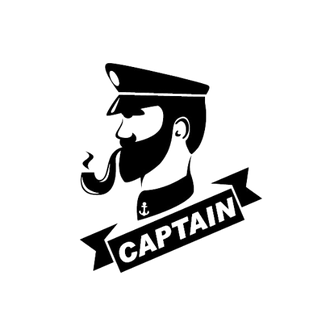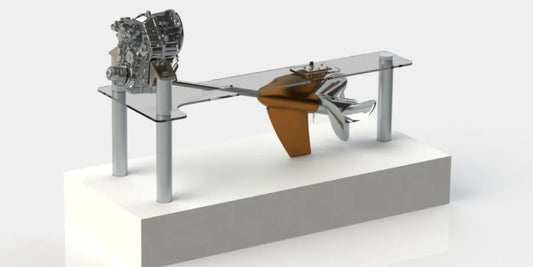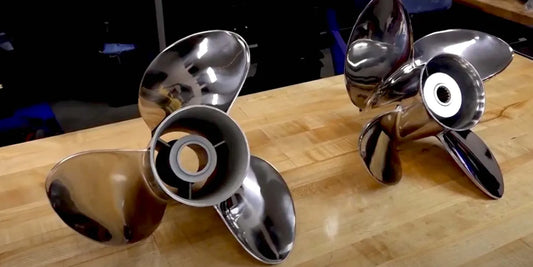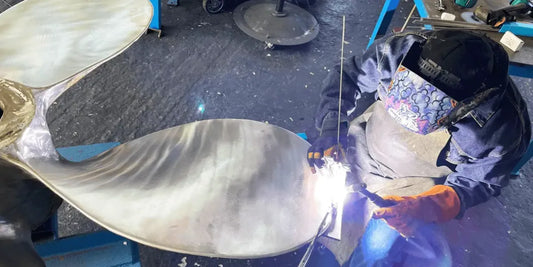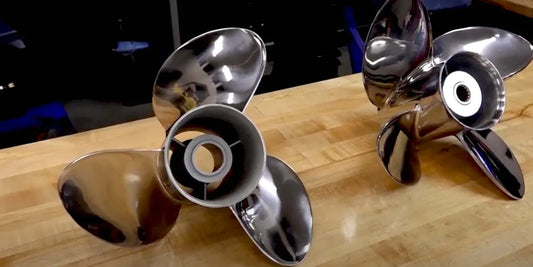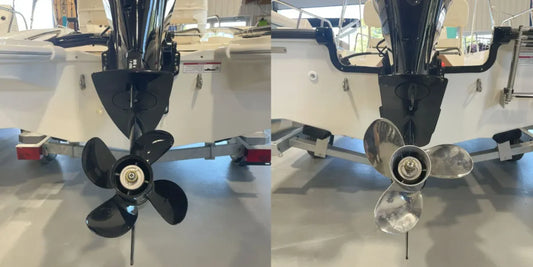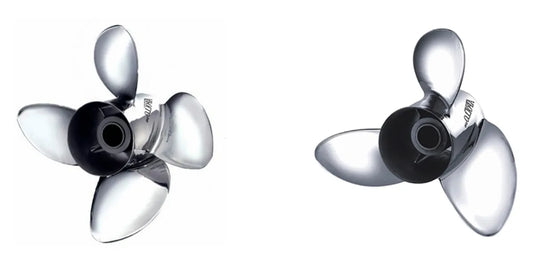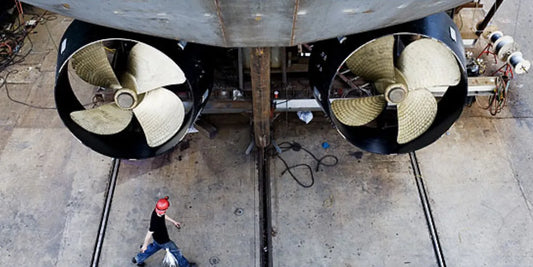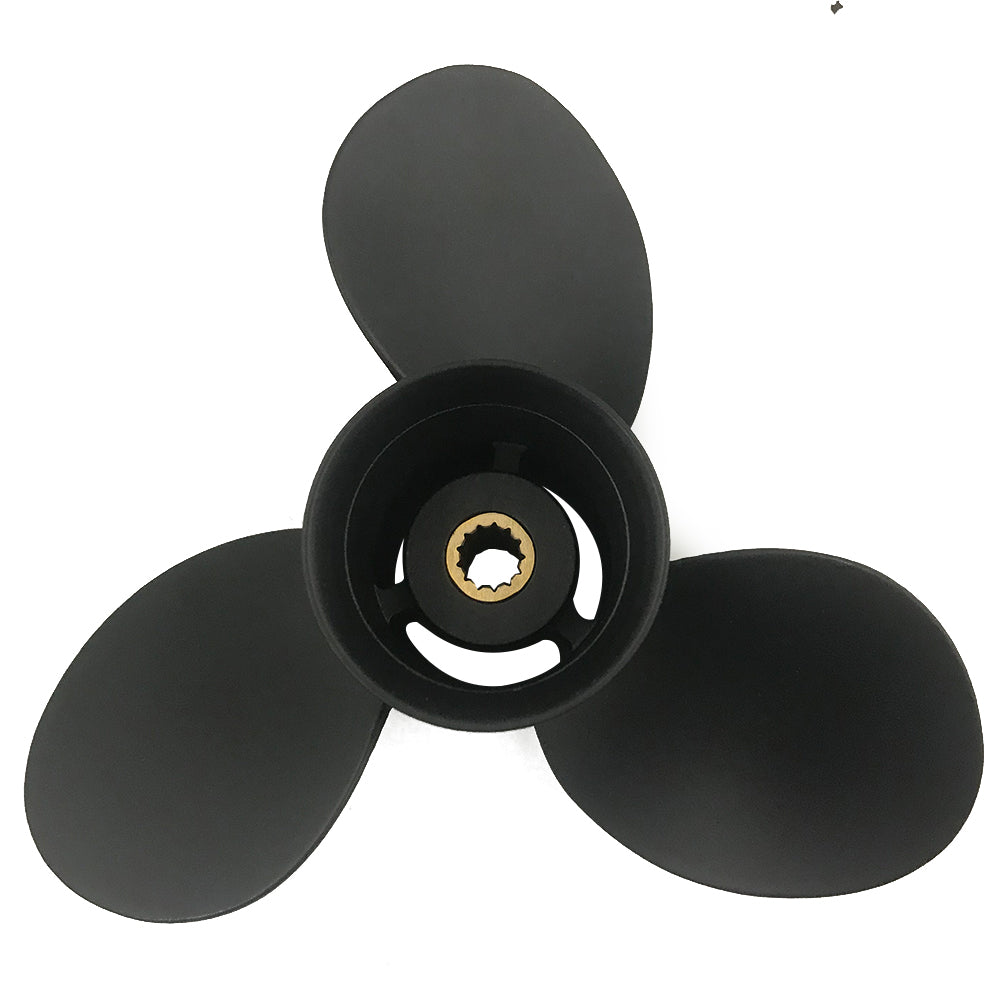Choosing between a 3-blade and a 4-blade propeller will have a significant impact on performance, efficiency, and overall enjoyment when engaging in waterborne activities with a speedboat. Each different propeller serves a distinct purpose; thus, understanding their differences becomes essential in making the right choice. This article examines the key differences between 3-blade and 4-blade propellers, allowing you to compare their performance in terms of speed, fuel consumption, handling, and versatility. Whether you define yourself as a casual boater or a full-blown performance fanatic, this guide will get you the knowledge you need to opt for the equipment that best addresses your requirements and goals.
Understanding Propeller Basics

What is a Propeller?
The propellers are essentially mechanical devices that comprise blades rotating to create thrust, allowing a vessel to move through either water or air. The blades are intricately designed to cut through the medium, thereby creating a pressure difference that propels the vessel forward. The propellers essentially work in conjunction with an engine; thus, their design and configuration significantly impact a craft's overall performance, fuel efficiency, and handling.
Modern developments in propeller technology involve various combinations of blade shape, material, and pitch to achieve the highest possible fuel conservation with the lowest possible drag. For instance, hydrodynamic alterations enhance water flow around the blade, while lighter materials, such as stainless steel or composites, offer better wear resistance without compromising speed. Knowledge of these technical aspects helps a boater make an informed choice regarding speed, fuel consumption, and the desired performance.
Working of Propeller Blades
The three propeller blades convert rotary motion into thrust, pushing the vessel through the water. A rotating propeller puts the blades into action, producing a difference in pressure between the forward and rear surfaces. Higher pressure at the back and lower at the front push the water backward to the rear, thereby propping the vessel forward. The design of the blade plays a fundamental role in the process. In other words, pitch implies displacement of water with every rotation; the greater the displacement, the faster the boat. If the blade is too large with the engine speed, the vessel will move very slowly, as it must push a large amount of water with each blade rotation.
Advanced computer-aided computational modeling emphasizes the blade shape, surface area, and number, insofar as ultimate performance is concerned. More surface area to a blade reduces cavitation; that is, vapor bubbles forming and collapsing near the blade, which, by the way, causes a reduction in efficiency and, with time, damage to the materials. Blade number and spacing shall be adjusted to counter water turbulence, ensuring even thrust is maintained constantly, and so forth. With this knowledge, the boat operator can evaluate the specific effects of one propeller configuration versus another on the factors of efficiency, speed, and durability, as related to the vessel's purpose and operational objectives.
Importance of Blade Design
Blade design plays a significant role in propeller functionality and efficiency. Considerations regarding thrust generation, durability, and fuel efficiency all factor into blade shape, size, and material composition. For example, recent developments in hydrodynamic modeling have enabled the design of blade profiles that reduce drag while enhancing flow dynamics, thereby minimizing energy loss in propulsion. The best materials to use nowadays include composite alloys that aim to elevate strength while maintaining low weight; they compete well because, given that weight is a factor, they tend to have long-term durability under extreme conditions. On the other hand, further optimization of the pitch variation curve smoothens the water displacement, ensuring less turbulence and lower noise pollution levels, thereby enhancing operational efficiency and passenger comfort. Pyramid Engineering and modern technologies are twin spirits; they work together to drive blade design, enhancing marine propulsion and reducing the environmental footprint in terms of energy consumption and emissions.
3 Blade Prop vs 4 Blade Prop: Key Differences

Performance characteristics of 3-blade propellers
3-blade propellers are renowned for their balanced speed, efficiency, and cost-effectiveness; hence, there is a wide range of applications where these props are used. These props have a smaller surface area compared to the 4-leaf ones, which minimizes drag in the water. This advantage is utilized in maximizing the top-end speed, especially in cases where speed has never been an issue, but mess handling has been. Less resistance creates a favorable environment for the engine to reach maximum RPM quickly and also provides impetus for maintaining fuel efficiency during operations.
Furthermore, three-bladed propellers generally provide very smooth performance in open-water conditions due to their consistent thrust. With some rare exceptions, they tend to offer less grip on hard turns or direct hits with rough water, as their lighter weight facilitates faster acceleration and enhances quick responsiveness. You will observe boaters opting for 3-blade props when the need for quickness and power outweighs the need for finesse in handling. Modern 3-blade propellers continue to be improved further with advanced materials and engineering enhancements, keeping them at the forefront of a truly versatile option.
Advantages of Using 4 Blade Propellers
Four-blade propellers offer several advantages, as they are perceived as being more stable and better performing under certain conditions, such as in calm waters to treacherous parent lows in high-sea, moody surface conditions. They generate better grip in rough waters, making towing and handling through choppy waters smoother. They provide better thrust when moving slowly, which is excellent for precise control at low speeds. The extra blade reduces vibrations, is more comfortable, and quieter. Although they are not the fastest possible, 4-blade propellers are the ones to choose if priority is given to efficiency, steady operation, and reliability under tough conditions.
Comparative Analysis of Speed and Efficiency
Given that speed and efficiency are two decisive features when considering applicability to different scenarios, propellers with three blades or those with four would be assessed accordingly. Three-blade propellers are built for speed. The fewer blades there are, the less drag is imparted to the boat, and hence it can cruise faster. They are perfect for boats designed for competitive racing or those that cover large distances rapidly. Since they strain the engine less at higher speeds, fuel efficiency will likely be greater, which is another point to consider if people intend to buy fuel-efficient setups to reduce fuel consumption during long journeys.
On the contrary, the 4-blade propellers tend to provide a more delicate balance of power and efficiency at low speed. The extra blade provides these propellers with more surface area for thrust, resulting in superior handling qualities in rough waters or when a boat is heavily loaded. While 4-blade propellers do not necessarily offer the highest top speed compared to 3-blade propellers, they do maintain better, more consistent performance and fuel efficiency, especially in towing, fishing, or navigating through shallow waters.
Fuel-wise, a 3-blade often consumes less fuel at high RPMs with low drag at constant speeds. Hence, 4-blade propellers, optimized according to variable fuel usage conditions, make them very adaptable for different boating needs. Decision-making between these two depends ultimately on a fine line between performance nuances, such as one that guarantees maximum speed or one that ensures dependable efficiency throughout varied and water conditions, both in and out of load. These considerations ensure a custom approach to propeller selection, providing significant enhancements to the overall vessel.
Choosing the Right Propeller for Your Boat

Factors to Consider When Selecting a Prop
Several factors come into consideration when choosing the right propeller for your boat, which can significantly impact the performance, fuel economy, and overall handling of the craft. One such consideration is the size of the propeller, which is usually expressed in terms of diameter and pitch. The diameter determines the amount of thrust generated; the pitch determines how far the boat and its load move forward with a single rotation. A correct balance between them yields maximum efficiency and speed.
Then comes the number of blades. More blades tend to increase stability and reduce vibration, thus resulting in a smoother ride; however, such props are slightly slower. For higher-speed applications, a three-blade propeller is mostly preferred. However, depending on whether one is after better mid-range performance and handling or carrying a heavier boat, four- or five-blade propellers would be chosen.
Material selection is also important in this regard, because aluminum propellers are lightweight and inexpensive, whereas stainless steel propellers are sturdier and provide good performance under high stress values. Stainless steel props are best suited for engaging in aggressive water activities or navigating choppy water.
The last option to consider is engine compatibility and the suitable RPM range for the engine-prop combination. Propellers should match the engine's recommended RPM and promote synergy between the propeller and engine, without overloading the engine. Each application is designed for a specific RPM range, so prop selection within this range ensures better fuel efficiency and less wear on internal engine components.
Hence, selecting the best propeller will, from your side, enhance the performance of your boat while meeting efficiency and durability appropriate for the activities and conditions under which you sail.
How Boat Type Affects The Choice Of The Propeller
The choice of propeller largely depends on the type of boat, as different types of vessels have varying purposes and functions under different conditions. For example, high-performance speedboats typically require propellers with high pitch and fewer blades to achieve greater speed and acceleration. On the contrary, pontoon boats are mainly intended to be enjoyed at a slow pace. Therefore, a propeller with low pitch and additional blades provides better assistance to thrust and maneuverability at low speeds.
When fishing boats operate in diverse bodies of water, ranging from shallow to semi-deep waters and all the way to the vast expanse of the seas, modular propellers must strike a balance between durability and power. The stainless steel propellers (STL) are highly appreciated for their resistance to wear, especially in waterways loaded with obstacles such as rocks or debris. In contrast, for displacement or heavy-type boats, such as trawlers or large yachts, the propellers must primarily focus on high torque and fuel efficiency to carry the heavy weight during long-distance cruising.
Pitch and Its Impact on Performance
Furthermore, the hull design influences the propeller diameters and pitch. Hull design: shape, length, and weight of a boat are all factors that determine the diameter and pitch of the propeller. While boats with V-shaped hulls may prefer larger diameters to maximize thrust available at greater depths. Understanding these nuances would help boat owners go for propellers suited to their vessel's exact mode of operation, thus benefiting from improved performance and reduced fuel consumption, not to mention their satisfaction.
Theoretical pitch distance, which is the distance a propeller moves while the shaft makes one revolution, often determines the performance of a boat. A low-pitch propeller generates significant thrust, making it well-suited for towing or slow-speed maneuvering. In contrast, high-pitch props favor higher top-end speeds by allowing more distance to be traversed per propeller revolution.
Data illustrate that inappropriately choosing a pitch can cause phenomena such as engine overloading or underperforming at optimal RPMs, thereby affecting engine life and fuel consumption. Water resistance, the load on the boat, and the power of the engine all affect pitch efficiency. If the pitch is set appropriately within the operating range recommended by the engine manufacturer, the performance will be smooth while simultaneously lowering strain and conserving fuel consumption.
Common Misconceptions About Blade Props

Myths About 3 and 4-Blade Options
It is said that four-blade propellers are generally considered superior to three-blade propellers in terms of speed and performance. However, although the fourth blade does provide smoother operation and better handling, especially in rough waters, it does not offer any significant increase in top-end speed. Conversely, 3-blade propellers can sometimes be more effective at achieving high speeds, as they create less drag and generate higher RPMs under similar conditions.
Additionally, some claim that 3-blade propellers consume more fuel than 4-blade propellers. The reality is that efficiency depends significantly on the boat's size, engine, and intended use. A much more speedy and agile 3-blade propeller will likely suit a lightweight boat; the 4-blade propeller will likely be better suited for larger boats that require stability and reduced cavitation.
It is also believed that having more blades results in better performance. The true answer is that in some instances, more blades may not be better. Acceleration, maneuverability, and even fuel consumption patterns become trade-offs relative to the number of blades. In simple terms, one should select according to the intended usage: towing, cruising, or racing, with the manufacturers' advice and testing being supreme.
Clarifying Confusion Over Blade Count
When considering blade count, one must weigh the trade-offs between speed, thrust, and efficiency. A three-blade propeller is generally chosen for applications where great top speed is desired because of its propensity to drift downwards due to drag in the water. Typically, smaller boats and vessels designed for high performance and speed opt for this choice. On the other hand, a four-blade propeller, which works quietly and provides control, is often preferable wherever steady handling is emphasized, such as in water sports or cruising.
The details may elaborate on further distinctions between four-blade propellers. Data show that four-blade configurations tend to promote fuel efficiency at lower speeds and, as such, are used for some long-distance towing applications. Racing vessels, on the other hand, often feature three-blade designs specifically designed for acceleration and top-end performance. In any case, findings suggest that an awareness of the interaction between blade count and operational scenarios shall help in making well-considered decisions that will provide the best results from both performance and resource consumption.
Expert commentary: Blade versus performance
The fitment of blade configurations to specific performance goals involved many factors. Several experts mention the following when showcasing the latest industry trends and data. It is found that lesser blade configurations, such as two-blade propellers, tend to offer greater efficiency and less drag, and are suitable for applications where speed and energy conservation are paramount—such as sport or racing craft. Multi-blade versions, such as four- and five-blade propellers, on the other hand, stand better in instances requiring stability, smoother operations, and a strong thrust —a recipe for handling heavy loads or choppy waters.
Hydrodynamics and thrust efficiency studies revealed that while more blades may slightly reduce the potential for top speed because of drag, they otherwise enhance mid-range operational efficiency and fuel efficiency under load. On the other hand, evolving design technologies, such as foil geometries and materials that offer low cavitation, help alleviate typical drawbacks. Especially, these enhancements enable manufacturers to optimally balance acceleration, vibration reduction, and fuel consumption across all blade types, wherever performance and efficiency are at stake.
Real-World Applications and Case Studies

Performance Testing: 3-Blade Against 4-Blade
Performance testing gives a slight advantage to either blade type for specific usages. Three-blade propellers tend to have higher top speeds for less drag, prioritizing speed and performance. In contrast, four-blade propellers provide more thrust and control when the load is heavy, with the additional blade potentially increasing the contact surface area between the blade and the water.
Under a load and power setup similar to the above, 3-blade propellers turn at higher RPMs, resulting in improved fuel economy when cruising over long distances or during high-speed operations. The 4-blade, on the other hand, is way ahead in stability, with less cavitation, better acceleration, and preferred in towing or navigating rough water.
Regarding fuel consumption, such distinctions in performance exist. While 3-blade variants economize fuel at cruising speeds, 4-blade ones save more when a significant load is applied, during rapid slowing down, or during maneuvering. Choosing between 3-blade and 4-blade propellers, therefore, depends directly on what the operator wants: maximum speed, stability, or versatile conditions under demand.
Feedback from Boat Owners and Enthusiasts
Boat owners and enthusiasts often compare the benefits of 3-blade and 4-blade propellers, as well as how array choices align with their specific applications. Many users praise 3-blade propellers for their higher top-end speeds and improved fuel efficiency during long-distance cruising, making them a preferred choice among recreational boaters who value streamlined travel. Conversely, 4-blade propellers are often recommended for improved control and stability in choppy conditions or for activities that involve frequent stopping and starting, such as fishing or towing.
Practical insights highlight the importance of striking a balance between performance and operational requirements. For example, according to feedback, boaters in heavy currents or with heavy loads prefer 4-blade designs, as they feel that thrust and precision are better. In contrast, speed enthusiasts consider the efficiency of 3-blade designs to be the best for maximizing their time cruising the open waters. These opposing viewpoints emphasize the need to select propellers not only according to vessel specifications but also according to the primary purpose for which the boat is used.
Selecting the Best Option for a Particular Need
When selecting the correct propeller design, it is essential to consider all the various boating conditions and performance requirements. For shallow and debris-filled waters, 4-blade propellers work best, as they offer more maneuverability and a lower probability of cavitation. In rougher conditions, they offer improved handling, which is particularly beneficial for recreational boat users or those seeking precise control. While traveling in free, calm waters, especially with lighter boats, or for maximizing fuel efficiency, 3-blade propellers are usually preferred for their high speed potential.
Drag reduction and engine loading are top priorities when considering parameters for performance optimization. The 3-blade type produces less drag due to its smaller surface area, resulting in better top speed. A 4-blade propeller, on the other hand, is known to give increased surface contact and grip to heavily loaded or towing boats. Once these dynamics are understood, one can optimize both the vessel's performance and fuel efficiency, as well as its strength and long-term maintenance costs.
Reference Sources
-
3 Blade vs. 4 Blade Propeller - Michigan Wheel
Explains the differences in pitch, performance, and efficiency between 3-blade and 4-blade propellers. -
3-Blade vs. 4-Blade Prop: What Are The Differences? - Reel Coquina Fishing
Highlights cost-effectiveness, maintenance, and performance aspects of 3-blade versus 4-blade props. -
4 Blade vs 3 Blade Propeller - The Hull Truth
Discusses RPM differences, efficiency, and specific use cases for each type of propeller.
Frequently Asked Questions (FAQs)
What are the advantages of 3-blade props versus 4-blade props?
Advantageously, a 3-blade propeller has speed and efficiency at higher speeds. Fewer blades mean less drag opposing the prop, which can improve overall performance in this regard. Also, as the 3-blade propellers tend to have the highest pitch, they are capable of faster acceleration during a hole shot. Therefore, boats used for recreation and those seeking speed and efficiency at the top end may want to opt for a 3-blade design. Weighty four-blade props can pull better than three-blade props at low speeds. Therefore, the best propeller becomes dependent on how the boat will be used.
How does a 4-blade prop compare with the 3-blade?
A 4-blade prop excels in hole shot and low-end performances. This type of feature is beneficial for many recreational boats that are used for navigating through rough waters or require a quick acceleration from the boat to ski. The potential 4th blade area, therefore, enables these props to pull well at low speeds and is thus a suitable choice for heavier loads or towing. This extra power is not without its cost - a 4-blade prop may be slightly less efficient at high speeds and, due to the drag, may also contribute marginally to a lower top speed. Ultimately, the choice between a 3-blade propeller and a 4-blade propeller rests with one's preferences and boating style.
How does the quantity of blades affect the maximum mileage of fuel obtained?
Fuel consumption and efficiency are influenced by the number of blades. Typically, the surface area of a 3-blade propeller is small enough to create less drag and allow for greater fuel economy at higher speeds. On the other hand, a 4-blade prop may exhibit good performance at low speeds but can be less efficient at higher RPMs, resulting in increased drag. That implies the 4-blade prop offers better hole shot and acceleration, yet it can cause increased fuel consumption in certain conditions. The boater should consider their typical use to decide which prop will enhance their fuel mileage.
Which pulls better, a 3-blade prop or a 4-blade prop?
Typically, 3-blade propellers seldom outperform 4-blade ones at slow rpm and low speeds. The added blade on a 4-blade prop provides an increased grip and surface area, propelling it better at low RPMs. For this reason, 4-blade propellers are usually better used for towing and skiing. However, a 3-blade propeller might pull better at higher speeds owing to less drag. Therefore, it depends on what the boat will be used for and whether low-speed thrust or top speed is more important.
What is the best prop for planning speed?
The best propeller type to achieve planing speed generally depends on the specific boat and its intended use. A 4-blade propeller would provide an improved hole shot, enabling the ship to reach planing speed more rapidly when fully loaded. This is favorable for recreational boats requiring fast acceleration for skiing and wakeboarding. However, to achieve maximum speed on a plane, they probably want to consider 3-blade propellers. Prop diameter, along with pitch, should be considered when selecting the best prop for planing performance.
How do pitch and blade area affect prop performance?
Pitch and blade area govern a propeller's performance characteristics. To put it simply, a higher pitch means a higher top speed, yet it will require more power to reach that top speed. Consequently, blade area controls and balances drag and efficiency; a propeller with less blade area will achieve greater speeds but may experience problems with acceleration and pulling power. For instance, a 4-blade propeller with a slight pitch might provide better low-speed performance, whereas a 3-blade propeller could excel at high speeds. Be aware of these characteristics so you can choose the right prop for any type of boating application.
